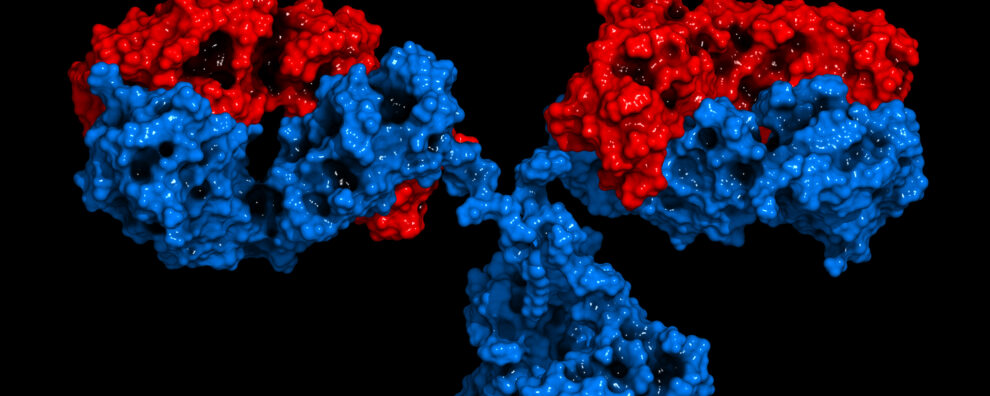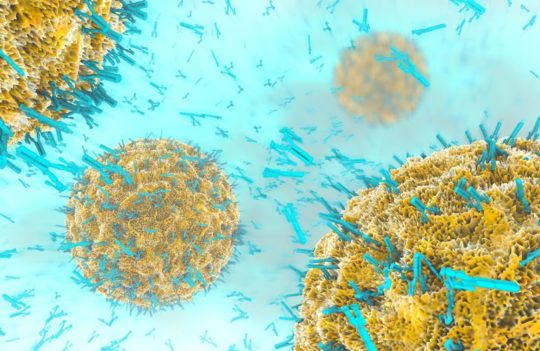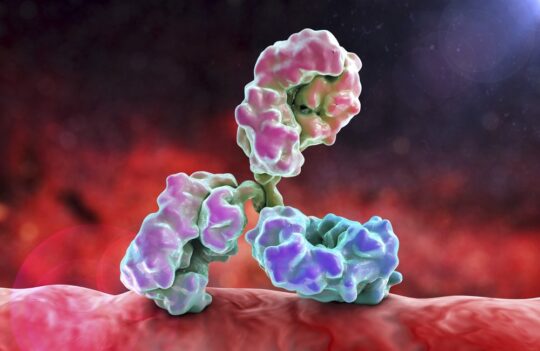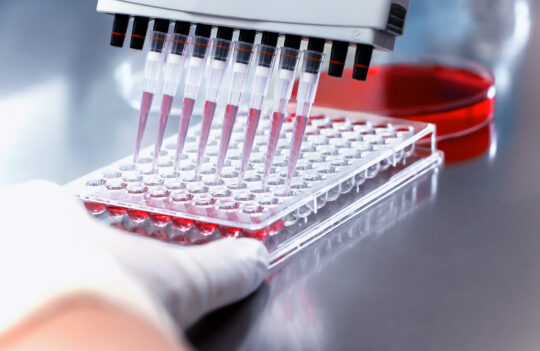 Antibody production
Antibody production
Unleashing the Future of Therapeutic Antibody Innovation
Imagine you're a scientist on the verge of a breakthrough, striving to develop a revolutionary therapeutic for a complex disease. This journey begins with a pivotal step: antibody discovery. Antibody discovery involves identifying and developing antibodies that can be used as therapeutic agents or diagnostic tools. This intricate process is fundamental to advancing modern medicine, offering highly targeted therapies with the potential to treat a wide range of diseases. Antibodies, or immunoglobulins, are Y-shaped proteins produced by B cells in response to antigens such as pathogens or malignant cells. Their unique ability to bind specifically to these antigens makes them powerful tools in both therapy and diagnostics. The development of monoclonal antibodies (mAbs) has revolutionized disease treatment, providing high specificity and efficacy with fewer side effects compared to traditional small molecule drugs. In this blog, we will take you through the comprehensive journey of antibody discovery and development. We will explore the key techniques and methodologies involved, including hybridoma technology, phage display, and single B-cell screening. We will also delve into the different antibody formats, such as full-length antibodies, fragments, scFv, bispecific antibodies, and nanobodies (VHH), highlighting their unique characteristics and advantages. Moreover, we will compare the advantages and limitations of antibody therapeutics versus small molecule drugs, providing a clear understanding of their roles in modern medicine. The blog will also address the challenges faced in antibody discovery and the strategies to overcome these obstacles, ensuring the successful advancement of therapeutic antibodies. By the end of this blog, you will have a thorough understanding of the antibody development process and how it can benefit your research and clinical applications. Additionally, you will discover how ProteoGenix’s extensive services and cutting-edge technologies can elevate your research, ensuring the successful realization of your antibody discovery projects. Dive into the fascinating and transformative world of antibody discovery, and let's embark on this journey together.
- What is Antibody Discovery?
- Definition and Basic Concepts
- The Importance of Antibody Discovery in Modern Medicine
- Antibody Discovery Techniques
- Overview of Key Techniques used for antibody discovery
- Step-by-Step Overview of the Antibody candidate discovery
- Antibody Discovery workflow
- Comprehensive Guide to Antibody Drug Discovery
- What is an Antibody Drug?
- Therapeutic Antibody Discovery Process
- Exploring Different Antibody Formats
- What are antibody fragments?
- The different antibody fragments
- Transform Your Antibody Discovery Project with ProteoGenix
- Elevate Your Research with Our Comprehensive Antibody Discovery Services
- Why Choose ProteoGenix for Your Antibody Discovery?
- Start Your Antibody Discovery Journey with ProteoGenix
What is Antibody Discovery?
Antibody discovery is the process of identifying and developing antibodies that can be used as therapeutic agents or diagnostic tools. This intricate process involves various techniques and workflows aimed at isolating high-affinity antibodies with specific target recognition. Understanding the fundamentals of antibody discovery is essential for appreciating its role in advancing modern medicine.
Definition and Basic Concepts
Antibodies are immunoglobulin proteins produced by B cells of the immune system. These Y-shaped molecules have the unique ability to bind specifically to antigens—such as pathogens or malignant cells—through their variable regions, thereby neutralizing the target. The discovery and development of monoclonal antibodies (mAbs) have revolutionized the field of medicine, providing highly targeted therapies for various diseases.
The Importance of Antibody Discovery in Modern Medicine
Antibody discovery is crucial for advancing therapeutic solutions and addressing unmet medical needs. The development of monoclonal antibodies has revolutionized disease treatment by offering highly targeted therapies that minimize side effects and enhance patient outcomes.
- Therapeutic Antibody Discovery:
Monoclonal antibodies are used to treat cancers, autoimmune diseases, and infectious diseases. They offer high specificity and efficacy with fewer side effects compared to traditional small molecule drugs. Therapeutic antibody development follows a rigorous antibody discovery workflow that includes target identification, antibody candidate discovery, and optimization. - Diagnostic Assays: Antibodies are essential components of many diagnostic tests, such as ELISA and immunohistochemistry, where they help in detecting specific biomarkers associated with diseases. This enables early diagnosis and monitoring of disease progression.
- Research Tools: In research, antibodies are used to study protein expression, localization, and function. They are also crucial in various laboratory techniques, including western blotting, flow cytometry, and immunoprecipitation.
Antibody Discovery Techniques
Overview of Key Techniques used for antibody discovery
Antibody discovery employs advanced techniques to identify and develop therapeutic antibodies. These methods are crucial for generating and screening large libraries of antibody candidates, optimizing their properties, and selecting the most promising candidates for further development. Key techniques in antibody discovery include:
- Hybridoma Technology:
Hybridoma technology is a foundational method in antibody development. This technique involves fusing B cells from immunized animals with myeloma cells to create hybridomas that produce monoclonal antibodies. The process begins with the immunization of animals to elicit an immune response. B cells from the spleen are then harvested and fused with myeloma cells, resulting in hybridoma cells capable of continuous growth and antibody production. These hybridomas are screened for the production of antibodies that exhibit high specificity and affinity towards the target antigen. Positive clones are subsequently isolated and characterized in detail. This technology is pivotal in therapeutic antibody discovery and development, offering a robust pipeline for antibody candidate discovery and optimization. - Phage Display:
Phage display is an in vitro technique that has become indispensable in the antibody discovery workflow. This method utilizes a library of antibody fragments displayed on the surface of bacteriophages to identify high-affinity binders. During the phage display process, phages displaying diverse antibody fragments are screened against the target antigen. Binding phages are selectively retained, amplified, and enriched through multiple rounds of biopanning. The genes encoding high-affinity antibody fragments are then sequenced, and the corresponding antibodies are expressed and thoroughly characterized. Phage display facilitates the rapid identification and optimization of therapeutic antibodies, streamlining the antibody drug discovery process. Explore our comprehensive Phage Display Technology Guide for more information. - Single B Cell Screening:
Single B cell screening is a powerful technique that isolates antigen-specific antibodies directly from individual B cells. This method involves isolating B cells from immunized subjects using advanced technologies such as flow cytometry or microfluidics. Once isolated, the antibody genes from these B cells are amplified, cloned, and expressed in host cells for recombinant antibody production. Single B cell screening provides a comprehensive view of the antibody repertoire, enabling the identification of antibodies with high specificity and affinity. This technique is particularly valuable in therapeutic antibody discovery and development, allowing for the precise characterization of antibody candidates. - Recent Trends and Developments in Antibody Discovery Techniques:
The field of antibody discovery is continuously evolving with the integration of innovative technologies and methodologies. Recent trends include the application of next-generation sequencing (NGS) for detailed antibody repertoire analysis and the use of artificial intelligence (AI) and machine learning for predictive modeling and optimization of antibody structures.
Step-by-Step Overview of the Antibody candidate discovery
Antibody Discovery workflow
The antibody discovery workflow is a meticulously structured process that ensures the identification and development of high-affinity antibodies for therapeutic and diagnostic purposes. This workflow encompasses multiple stages, each critical for the successful generation of effective antibody candidates. Below, we provide a detailed step-by-step overview of this comprehensive process:
- Target Identification and Validation
The first step in the antibody discovery workflow is the identification and validation of a suitable target antigen. This stage involves selecting antigens associated with diseases such as cancer, autoimmune disorders, or infectious diseases. Advanced bioinformatics tools and experimental methods are employed to ensure the target is relevant and accessible for antibody binding. Effective target identification and validation are foundational to antibody development and crucial for guiding subsequent stages of the antibody discovery process. - Antigen Preparation
Once a target is identified, the next step is antigen preparation, which involves producing and purifying the target antigen to generate a stable and high-quality supply for immunization or in vitro screening. Proper antigen preparation is crucial, as it directly impacts the efficiency of the antibody discovery workflow. High-quality antigens ensure robust immune responses and accurate screening results, which are vital for therapeutic antibody discovery and development. - Immunization and Library Generation
For in vivo methods, animals are immunized with the prepared antigen to elicit an immune response. This stimulates B-cells to produce diverse antibodies. Alternatively, synthetic libraries can be generated in vitro, creating vast antibody repertoires using combinatorial biology techniques. This step is essential for antibody candidate discovery, as it generates the diverse pools of antibodies needed for screening and selection. Immunization and library generation are key components of the antibody discovery workflow, setting the stage for identifying high-affinity antibodies. - Screening and Selection
Screening involves identifying high-affinity antibodies from the generated libraries. Techniques such as hybridoma technology, phage display, and single B-cell screening are employed to isolate antibodies that specifically bind to the target antigen. This stage includes multiple rounds of selection to enrich for the best candidates. Efficient screening and selection techniques are essential for therapeutic antibody development, as they help narrow down the vast antibody repertoires to a few high-potential candidates for further development. - Characterization and Optimization
Selected antibodies undergo thorough characterization to assess their binding affinity, specificity, and functional activity. Techniques such as ELISA, surface plasmon resonance (SPR), and flow cytometry are used for detailed analysis. Optimization may involve affinity maturation and engineering to enhance therapeutic properties. Characterization and optimization are crucial steps in refining antibody development, providing insights into the antibody’s potential efficacy and safety profiles, and ensuring that the most promising candidates are advanced through the antibody development timeline. - Production and Validation
The final step involves scaling up the production of the optimized antibodies and validating their efficacy in preclinical models. This includes producing antibodies in mammalian cell cultures and conducting in vitro and in vivo assays to confirm their therapeutic potential. Successful antibody drug development depends on reliable production and validation processes. Preclinical validation is a critical part of the therapeutic antibody discovery process, ensuring that the candidate antibodies demonstrate the desired therapeutic effects and safety before advancing to clinical trials.
Comprehensive Guide to Antibody Drug Discovery
What is an Antibody Drug?
An antibody drug is a therapeutic agent composed of monoclonal antibodies that specifically target disease-associated antigens. These drugs harness the body’s immune system to recognize and neutralize pathogens or diseased cells. Antibody drug discovery involves identifying high-affinity antibodies through a rigorous antibody discovery workflow, optimizing their properties for therapeutic use, and developing them into effective treatments. Antibody drugs are characterized by their high specificity and potency, making them ideal candidates for treating various conditions such as cancer, autoimmune diseases, and infectious diseases.
Therapeutic Antibody Discovery Process
The therapeutic antibody discovery process is a multi-step approach designed to identify, optimize, and develop antibodies with therapeutic potential. This process integrates various techniques and methodologies to ensure the successful translation of an antibody candidate from initial discovery to clinical application.
- Target Identification and Validation: The therapeutic antibody discovery process begins with target identification and validation. This step involves gathering evidence to support the selection rationale, experimentally validating the target, and establishing a project plan. This ensures that the chosen target is relevant and accessible for antibody binding, forming the foundation of the antibody discovery workflow.
- Screening Preparation: Following target validation, the next phase is screening preparation. This includes reagent generation for assay development, and screening for specificity, affinity, and functionality testing. Evaluating non-cross-reactive antibodies at this stage is crucial to ensure specificity in therapeutic antibody development.
- Hit Generation and Lead Selection: This step involves generating antibody hits using display and hybridoma technologies. Selected lead molecules are screened for favorable biochemical and biophysical properties. In vivo efficacy is demonstrated, and epitope mapping is conducted to ensure precise targeting. This stage is integral to the antibody candidate discovery process.
- Lead Optimization and Characterization: Antibody candidates undergo optimization to enhance their therapeutic properties. This includes humanization, affinity maturation, and assessing in vivo efficacy. Exploratory safety studies and biomarker development are also conducted. Characterization ensures the antibodies meet the required standards for therapeutic use, aligning with the antibody development timeline.
- Candidate Selection: At this stage, a thorough examination of scientific data is performed, including risk and safety assessments. Commercial viability, legal evaluation, and clinical planning are also assessed. Regulatory and manufacturing plans are established to prepare for clinical development.
- Production and Preclinical Development: Optimized antibodies are produced using transient expression or stable cell lines for characterization. Preclinical testing involves in vitro and in vivo assays to evaluate efficacy, safety, and pharmacokinetics. This ensures the therapeutic potential of the antibody candidates before advancing to clinical trials.
- Clinical Development: Promising antibody candidates progress to clinical trials, which are conducted in multiple phases to assess safety, efficacy, dosage, and overall therapeutic potential in humans. The antibody development timeline for clinical trials typically spans several years and involves close collaboration with regulatory bodies.
- Regulatory Approval: Successful clinical trials lead to regulatory submissions and approvals. Regulatory agencies thoroughly review the clinical data to ensure that the antibody drug meets all safety and efficacy standards before it can be marketed.
Exploring Different Antibody Formats
What are antibody fragments?
One significant limitation of using full-sized monoclonal antibodies as therapeutic agents is their poor delivery efficiency, particularly when targeting cancerous tumors. Full-length antibodies often struggle to penetrate the center of solid tumors due to substantial physical barriers, which diminishes their therapeutic effectiveness. This challenge has prompted researchers to explore the use of antibody fragments, which offer better tumor penetration and facilitate radiolabeled imaging or effective therapeutic delivery.
Antibody fragments, including scFvs, Fabs, and VHH fragments, retain the antigen-binding capacity of whole antibodies while being smaller and more versatile. These fragments are particularly useful in applications where sufficient epitope binding is critical, such as virus neutralization or receptor blocking. The smallest antigen-binding fragment is the Fv fragment, composed solely of variable (V) regions, which can be linked to form scFvs or combined with constant (C) domains to create Fab fragments. Antibody fragments like scFvs and Fabs are easily produced in prokaryotic hosts and are widely used due to their beneficial properties.
Antibody fragments play a crucial role in the development of therapeutic antibodies, with the specific type of fragment chosen depending on the disease and application. In the next section, we will explore the different antibody formats in detail, highlighting their unique characteristics and advantages in therapeutic and diagnostic applications.
The different antibody fragments
- Full-Length Antibodies
Full-length antibodies, such as IgG antibodies, are widely used in therapeutic applications due to their high specificity, long half-life, and ability to mediate effector functions. These antibodies are essential in treating diseases like cancer and autoimmune disorders - Fragment Antibodies
Fragment antibodies, including Fab fragments, consist of only the antigen-binding regions of full-length antibodies. They offer increased tissue penetration and reduced immunogenicity, making them suitable for specific diagnostic and therapeutic applications. - Single-Chain Variable Fragments (scFv)
Single-chain variable fragments (scFv) are composed of the variable regions of heavy and light chains connected by a flexible linker. Their small size and high specificity make them ideal for targeting tumors and for use in research. - Bispecific Antibodies
Bispecific antibodies can bind two different antigens simultaneously, enhancing therapeutic efficacy by targeting multiple disease pathways. They are particularly useful in cancer therapy, where they can redirect T-cells to tumor cells - Antibody-Drug Conjugates (ADCs)
Antibody-drug conjugates (ADCs) combine antibodies with cytotoxic drugs, enabling targeted delivery of chemotherapy agents directly to cancer cells. This approach minimizes off-target effects and enhances therapeutic outcomes. For more information, visit our antibody-drug conjugates in cancer therapy blog page. - Nanobodies (VHH)
Nanobodies, or VHH antibodies, derived from camelids, are single-domain antibodies known for their small size, high stability, and ability to access hidden epitopes. They are valuable in diagnostic imaging and as therapeutic agents. - Multispecific Antibodies
Multispecific antibodies are designed to target multiple epitopes or antigens simultaneously, offering the potential to engage multiple disease pathways and improve therapeutic efficacy. They are emerging as powerful tools in treating complex diseases like cancer and infectious diseases.
Challenges in Antibody Discovery
The process of antibody discovery is complex and fraught with numerous challenges. Overcoming these obstacles is essential for the successful development of therapeutic antibodies. Below, we outline some common challenges in antibody discovery and the strategies used to address them.
| Common Obstacles and Issues | Challenges | Solutions |
|---|---|---|
| Target Identification and Validation | Identifying suitable and disease-specific targets is fundamental to the antibody discovery workflow. Incorrect or poorly validated targets can lead to ineffective antibody candidates. The specificity and accessibility of the target antigen are critical for the subsequent success of antibody binding and therapeutic efficacy. | Use advanced bioinformatics tools, such as genomic and proteomic databases, to identify potential targets. Comprehensive literature reviews and robust experimental validation, including knockdown or knockout studies and in vitro binding assays, ensure the relevance and accessibility of targets. |
| Antibody Generation and Screening | Generating a diverse library of high-affinity antibodies and screening these libraries to identify the best candidates can be time-consuming and resource-intensive. Ensuring a broad and high-quality antibody library is essential for finding effective candidates. | Implement high-throughput screening technologies such as phage display, which allows for the rapid identification of high-affinity antibodies from large libraries. Single B-cell screening can provide a direct source of high-affinity antibodies from immunized animals. Utilizing next-generation sequencing (NGS) enhances the diversity and accuracy of library screening. |
| Optimization and Affinity Maturation | Optimizing antibodies for improved binding affinity, stability, and reduced immunogenicity requires sophisticated techniques and extensive testing. Poorly optimized antibodies may have suboptimal therapeutic effects or adverse immunogenic responses. | Employ directed evolution techniques, such as error-prone PCR and ribosome display, to enhance antibody affinity and stability. Computational modeling and in silico prediction tools can guide rational design and optimization. In vitro affinity maturation techniques, such as yeast or phage display, allow for iterative improvements in antibody properties. |
| Production and Scale-Up | Scaling up antibody production while maintaining quality and consistency is difficult, especially during the transition from research to clinical-grade manufacturing. The production process must be robust and reproducible to meet clinical and commercial demands. | Develop robust and scalable bioprocessing protocols using mammalian cell expression systems, such as CHO (Chinese Hamster Ovary) cells, which are commonly used for large-scale antibody production. Implement stringent quality control measures, including real-time monitoring and analytical testing, to ensure consistency and purity. |
| Preclinical and Clinical Testing | Ensuring antibodies are safe and effective in preclinical models and during clinical trials involves significant risks, including potential toxicity and lack of efficacy. Unanticipated adverse effects or inadequate therapeutic responses can halt development. | Conduct thorough preclinical evaluations using a combination of in vitro assays (e.g., cell viability, binding affinity) and in vivo models (e.g., xenograft mouse models) to assess efficacy and safety. Design adaptive clinical trial protocols that allow for modifications based on interim results. Early-stage humanized mouse models can provide insights into human-specific responses. |
| Regulatory Approval | Navigating the regulatory landscape to achieve approval for antibody therapeutics involves extensive documentation and meeting stringent safety and efficacy standards. The regulatory process can be lengthy and complex, requiring detailed submissions and adherence to guidelines. | Engage with regulatory agencies early in the development process to understand requirements and expectations. Prepare comprehensive and well-documented submissions, including detailed clinical trial data, manufacturing processes, and quality control measures. Leveraging regulatory expertise and consulting with specialists can streamline the approval process. |
Transform Your Antibody Discovery Project with ProteoGenix
Elevate Your Research with Our Comprehensive Antibody Discovery Services
ProteoGenix is dedicated to providing unparalleled support for your antibody discovery projects. Our extensive range of services and innovative technologies ensure that your research reaches its full potential. Here’s how we can assist you:
Why Choose ProteoGenix for Your Antibody Discovery?
- Cutting-Edge Technology: We leverage advanced techniques such as hybridoma technology, phage display, and single B-cell screening to ensure the identification of high-affinity antibodies tailored to your needs.
- Comprehensive Antibody Formats: Whether you require Fab fragments, scFv, nanobodies (VHH), bispecific antibodies, or antibody-drug conjugates (ADCs), our extensive expertise ensures you get the best format for your therapeutic and diagnostic applications.
- End-to-End Solutions: From target identification and validation to antibody optimization and regulatory support, we provide a seamless workflow that enhances efficiency and accuracy in your antibody development process.
- Expert Support: Our team of experienced scientists and regulatory experts offers personalized support throughout your project, ensuring the highest quality and compliance with industry standards.
- Proven Track Record: With numerous successful projects and publications, ProteoGenix has established itself as a trusted partner in the field of antibody discovery.
Start Your Antibody Discovery Journey with ProteoGenix
Partner with ProteoGenix to transform your antibody discovery project. Our commitment to quality, innovation, and customer satisfaction ensures that you achieve outstanding results.
Ready to elevate your research? Contact us today to learn how our comprehensive services can support your antibody discovery needs. Get Started with ProteoGenix.




